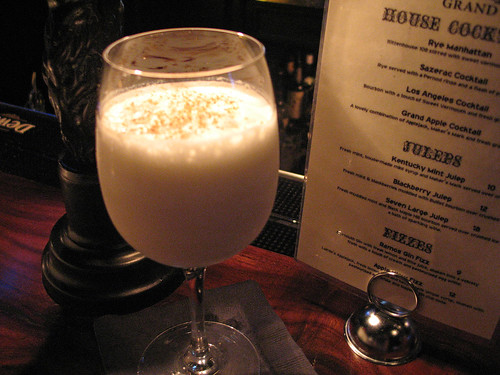Lá Fhéile Pádraig Sona Duit! (Happy St. Patrick’s Day, and all that.) Ná cuir ceist orm … níl a fhois agam! (I do know, actually; I just like saying that.) Oh, and NO feckin’ green beer today, please. Black.
Okay, so it’s St. Patrick’s Day … there may be drinking involved. (No! I don’t believe it!)
If I were to offer a Cocktail of the Day today, it might be simply this:
Guinness Draught
One pint Guinness, poured properly. Sip through the head. Savor. Enjoy. Repeat.
There’s a caveat, though — make sure that the places you order Guinness from the tap actually do it well. A couple of weeks ago we went with some friends to The Knitting Factory in Hollywood to see The Sacred Cowboys, a country/Southern rock band whose lead singer is W. Earl Brown, whom you may know better as Dan Dority, Al Swearingen’s evil henchman on “Deadwood”. They were great, but I swear … the Guinness I was served there was without a doubt the most god-awful pint it has ever been my displeasure to have pass my lips. It tasted old, stale, heavily metallic and … well, Jaysis knows what other shite was in that line. It may have been the single most disagreeable pint of Guinness served to anyone since Arthur Guinness started his brewery in Dublin in 1759. Needless to say, do not ever order a Guinness at The Knitting Factory. (Andy said even the whiskey tasted “off”, so you’re probably better off with bottled beer.)
If there isn’t a decent pub in your neighborhood, apparently you can just order a pre-built pub and they’ll deliver it to you (which I find fascinating and bizarre).
Speaking of whiskey … it should be Irish this weekend, of course. We have a pretty decent collection at home, consisting of, if I recall correctly: John Powers Gold Label, John Powers 12 Year Old, Jameson, Jameson 12 Year Old, Tullamore Dew, Kilbeggan, Locke’s 8 Year Old Single Malt, Redbreast 12 Year Old, Paddy, Bushmills, Bushmills 10 Year Old Single Malt, Bushmills 21 Year Old, Midleton Very Rare 2003.
There will be sipping.
Then there’s the cocktail question. Well, sad to say, Ireland isn’t much of a cocktail-drinking country. I love the pints and the pure drop, but when were were last there I did miss the ould cocktail. (The Octagon Bar at the Clarence in Dublin filled the bill, although at an eye-popping €15.50 per drink for starters.)
There isn’t really a “typically Irish” cocktail, although you’ll see lots of things with Irish names, many green for the sake of being green, and that greenness coming from awful doses of green crème de menthe. (“What about Irish Coffee?” you ask. Follow the link for a bit on that.)
There’s one cocktail I’m quite fond of that’s becoming associated with this day, although I doubt that a single person in Ireland will drink one today (as opposed to the 150 pints of Guinness that are being pulled per second for each of the 24 hours of St. Paddy’s Day). It’s Irish whiskey-based and quite lovely, but calls for a bit of a tolerance for the intensely herbal liqueur Chartreuse (a tolerance very much worth acquiring). I believe the original recipe came from Hugo Ensslin in 1919, but this is the version appearing in the Savoy Cocktail Book:
The Tipperary Cocktail
(original version)
3/4 ounce Irish whiskey.
3/4 ounce green Chartreuse.
3/4 ounce sweet vermouth.
Stir with ice for no less than 30 seconds and strain into a cocktail glass.
In yesterday’s edition of The Cocktailian, Gary Regan’s fortnightly column in the San Francisco Chronicle, The Professor, our cocktailian bartender, offers a different version; same ingredients, different proportions — “More whiskey, less vermouth, less Chartreuse.” This is the way to go for me.
The Tipperary Cocktail
(The Professor’s modern variation)
2 ounces Irish whiskey.
1 ounce sweet vermouth.
1/4 ounce green Chartreuse.
Pour the Chartreuse into a chilled cocktail glass, and by tilting the glass and rotating it at the same time, coat the entire interior of the glass. Discard the excess Chartreuse. Fill a mixing glass two-thirds full of ice and add the whiskey and the vermouth. Stir for approximately 30 seconds and strain into the prepared cocktail glass.
Plus there’s the Dubliner, and its sibling, my own St. Dominic’s Preview. I think you’ll have plenty to drink to celebrate the day. If you do follow all of the above suggestions … well, try to space them out a bit.
P.S. — Here’s a version of the Tipperary from Larousse des Cocktails by Fernando Castellon in which he uses rye instead of Irish. It’s a good variation, but you’re not allowed to make it on St. Patrick’s Day. Use a nice, big, spicy rye and the best sweet vermouth you’ve got (Carpano Punt E Mes or Antica Formula).
Tipperary Cocktail No. 2
2 ounces rye whiskey.
1 ounce sweet vermouth.
1/2 ounce green Chartreuse.
Stir with ice; strain into a cocktail glass.
Version française, Larousse des Cocktails
4 cl de rye whiskey
2 cl de vermouth rosso
1 cl de liqueur Chartreuse verte
5 ou 6 glaçons
Mettez les glaçons et les ingrédients dans le verre à mélange.
Remuez à l’aide d’une cuillère à mélange pendant 8 à 10 secondes.
Filtrez au-dessus du verre martini à l’aide d’une passoire à glaçons.
Servez aussitôt.






